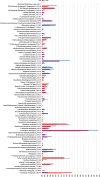Macroalgal microbiomes unveil a valuable genetic resource for halogen metabolism
- PMID: 38454513
- PMCID: PMC10919026
- DOI: 10.1186/s40168-023-01740-6
Macroalgal microbiomes unveil a valuable genetic resource for halogen metabolism
Abstract
Background: Macroalgae, especially reds (Rhodophyta Division) and browns (Phaeophyta Division), are known for producing various halogenated compounds. Yet, the reasons underlying their production and the fate of these metabolites remain largely unknown. Some theories suggest their potential antimicrobial activity and involvement in interactions between macroalgae and prokaryotes. However, detailed investigations are currently missing on how the genetic information of prokaryotic communities associated with macroalgae may influence the fate of organohalogenated molecules.
Results: To address this challenge, we created a specialized dataset containing 161 enzymes, each with a complete enzyme commission number, known to be involved in halogen metabolism. This dataset served as a reference to annotate the corresponding genes encoded in both the metagenomic contigs and 98 metagenome-assembled genomes (MAGs) obtained from the microbiome of 2 red (Sphaerococcus coronopifolius and Asparagopsis taxiformis) and 1 brown (Halopteris scoparia) macroalgae. We detected many dehalogenation-related genes, particularly those with hydrolytic functions, suggesting their potential involvement in the degradation of a wide spectrum of halocarbons and haloaromatic molecules, including anthropogenic compounds. We uncovered an array of degradative gene functions within MAGs, spanning various bacterial orders such as Rhodobacterales, Rhizobiales, Caulobacterales, Geminicoccales, Sphingomonadales, Granulosicoccales, Microtrichales, and Pseudomonadales. Less abundant than degradative functions, we also uncovered genes associated with the biosynthesis of halogenated antimicrobial compounds and metabolites.
Conclusion: The functional data provided here contribute to understanding the still largely unexplored role of unknown prokaryotes. These findings support the hypothesis that macroalgae function as holobionts, where the metabolism of halogenated compounds might play a role in symbiogenesis and act as a possible defense mechanism against environmental chemical stressors. Furthermore, bacterial groups, previously never connected with organohalogen metabolism, e.g., Caulobacterales, Geminicoccales, Granulosicoccales, and Microtrichales, functionally characterized through MAGs reconstruction, revealed a biotechnologically relevant gene content, useful in synthetic biology, and bioprospecting applications. Video Abstract.
Keywords: Asparagopsis taxiformis; Halopteris scoparia; Sphaerococcus coronopifolius; Dehalogenation; Halogenation; Holobiont; Macroalgae; Metagenome-assembled genomes (MAGs); Microbiome; Organohalogens.
© 2024. The Author(s).
Conflict of interest statement
The authors declare no competing interests.
Figures





Similar articles
-
Short-Term Memory Impairment.2024 Jun 8. In: StatPearls [Internet]. Treasure Island (FL): StatPearls Publishing; 2025 Jan–. 2024 Jun 8. In: StatPearls [Internet]. Treasure Island (FL): StatPearls Publishing; 2025 Jan–. PMID: 31424720 Free Books & Documents.
-
Phylogenetic and functional diversity among Drosophila-associated metagenome-assembled genomes.mSystems. 2025 Jul 22;10(7):e0002725. doi: 10.1128/msystems.00027-25. Epub 2025 Jul 2. mSystems. 2025. PMID: 40600712 Free PMC article.
-
Comparison of self-administered survey questionnaire responses collected using mobile apps versus other methods.Cochrane Database Syst Rev. 2015 Jul 27;2015(7):MR000042. doi: 10.1002/14651858.MR000042.pub2. Cochrane Database Syst Rev. 2015. PMID: 26212714 Free PMC article.
-
Factors that influence parents' and informal caregivers' views and practices regarding routine childhood vaccination: a qualitative evidence synthesis.Cochrane Database Syst Rev. 2021 Oct 27;10(10):CD013265. doi: 10.1002/14651858.CD013265.pub2. Cochrane Database Syst Rev. 2021. PMID: 34706066 Free PMC article.
-
Sexual Harassment and Prevention Training.2024 Mar 29. In: StatPearls [Internet]. Treasure Island (FL): StatPearls Publishing; 2025 Jan–. 2024 Mar 29. In: StatPearls [Internet]. Treasure Island (FL): StatPearls Publishing; 2025 Jan–. PMID: 36508513 Free Books & Documents.
Cited by
-
Metagenomic study of lake microbial mats reveals protease-inhibiting antiviral peptides from a core microbiome member.Proc Natl Acad Sci U S A. 2024 Dec 3;121(49):e2409026121. doi: 10.1073/pnas.2409026121. Epub 2024 Nov 25. Proc Natl Acad Sci U S A. 2024. PMID: 39585984 Free PMC article.
-
Abiotic stress destabilizes the bacterial community of sugar kelp, Saccharina latissima (Phaeophyceae).J Phycol. 2025 Aug;61(4):840-857. doi: 10.1111/jpy.70033. Epub 2025 May 28. J Phycol. 2025. PMID: 40432552 Free PMC article.
-
Contrasting diversity and temporal patterns in leaf and root microbiome of two nearby temperate Zostera marina meadows.Environ Microbiome. 2025 Aug 5;20(1):98. doi: 10.1186/s40793-025-00760-z. Environ Microbiome. 2025. PMID: 40765019 Free PMC article.

